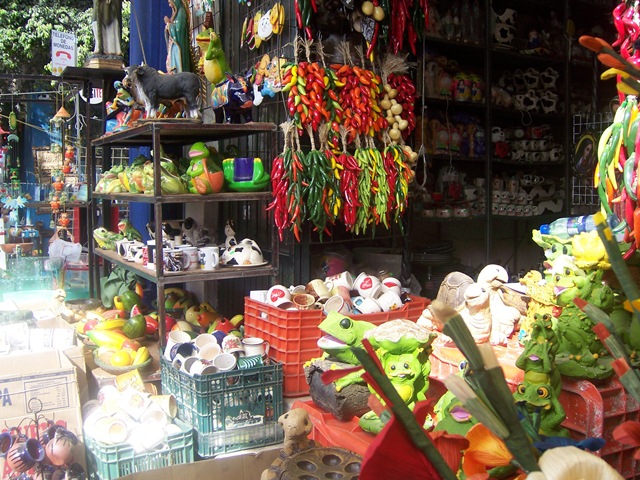Tonala and Tlaquepaque….no, neither a singing duo nor a rock group, but sister cities southeast of Guadalajara where you can shop till you drop and do much less damage to your pocketbook than you would have ever thought possible.
Some people still consider Tlaquepaque and Tonala “suburbs” of Guadalajara, but with the population of the former nearing half a million and the latter hovering around 350,000, that seems a bit of a misnomer.
Getting there from Zihua is easy even if you don’t have a car. Take the 440 peso overnight bus that leaves Estrella de Oro around midnight and you’ll pull into Guadalajara’s huge eight module bus station (numbered one through seven with 1-1/2 tucked in there as well) by eight a.m. — sometimes nearly an hour earlier if traffic is light.
A taxi to downtown Tonala will run about 60 pesos, and Tlaquepaque shouldn’t be more than 75 pesos, tops. If you’re feeling more adventurous, an air-conditioned, turquoise local “TUR” bus will drop you off a few blocks from “el centro” in either place for less than 10 pesos apiece.
Now, which place to visit? Tlaquepaque is definitely the more upscale of the two destinations, but our most recent trip to Tonala in September, 2006, found the hospitality industry kicking into higher gear with the addition of a couple new hotels and a handful of new restaurants since early 2005. Likening the two cities to Zihua’s two supermarkets, one could say Tlaquepaque resembles Comercial while Tonala tends more towards the warehouse feel of Bodega. In general, I found prices to be somewhat lower in Tonala, but there’s something to be said for the fashionable ambiance of Tlaquepaque. If you have a couple of days to spend, visit both and decide for yourself.
Both places sell immense quantities of ceramics, textiles, bed and table linens, rustic and modern furniture, pewter, blown glass, leather goods, and countless handicraft items. Wholesalers from throughout Mexico — and the rest of the world as well — come to take advantage of the bounty and resell it elsewhere for a handy profit. Art galleries in both locales (and there are plenty) cater to a variety of tastes, and an increasing number of restaurants and lounges also display local artwork and offer it for sale.
A must when in Tlaquepaque is a visit to El Parián, located in the heart of the downtown area. There’s a central entertainment area surrounded by 17 cantinas and restaurants which occupy a quadrant one block long on each side. Depending on the time of day and the day of the week, you can expect to be serenaded by mariachis or treated to a folkloric ballet performance. Even if there’s no formal show going on inside, the people-watching opportunities from the tables ringing the outside of El Parián frequently present interesting spectacles. Sit back and stare from behind your sunglasses while you wash down a torta ahogada (an open-faced sandwich drowned in red sauce) with an ice-cold cerveza.
Similarly, a visit to Tonala would be incomplete without experiencing a tianguis, or open-air market. These day-long events are held all year round on Sundays and Thursdays and transform the downtown area into a gigantic, teeming mass of humanity threading its way slowly between hundreds and hundreds of vendors from eight a.m. until about four p.m. The stuff you can buy at these things boggles the mind.
Besides everything mentioned earlier in this article, you’ll see folks carrying litters of puppies in baskets, handmade Christmas decorations, hardware, electronics, hair extensions, wheelbarrows full of underwear, all kinds of prepared food you can eat while you continue elbowing your way through the crowd, knickknacks, blankets, baseball caps, luggage, made-in-Hong-Kong junk, one-of-a-kind hand-crocheted shawls, dollhouse furniture, incense, plants, religious icons, oodles of miniatures, and the list goes on and on.
A big part of the fun of a tianguis is the county fair atmosphere pervading the festivities. One of the challenges for the directionally impaired (a group in which I hold lifetime membership) is NOT getting lost.
Both cities boast accommodations ranging from the relatively cheap (about 300 pesos a night for two in Tonala and about 400 pesos in Tlaquepaque) to the luxurious, with an ever-growing number of tastefully appointed bed-and-breakfast options and boutique hotels among the choices.
If you find you’re all shopped out, there are museums, parks, churches and a variety of other buildings to explore. And if you need a bigger playground than what you find in either of these artisan-rich enclaves, hop a bus to Guadalajara. That trip will take around 30 to 40 minutes if you opt for the turquoise TUR buses that whisk you downtown with relatively few stops. If you want to experience more local flavor, then get aboard one of the many combis that give you a twisty, turny, often bumpy ride through many typical neighborhoods before depositing you in the central part of Mexico’s second largest city about an hour later.
An online search will net you scads of websites to pull up for both locations. Two to get you started are www.descubretlaquepaque.com and www.tonala.gob.mx
-Originally Publilshed in March 2007.




